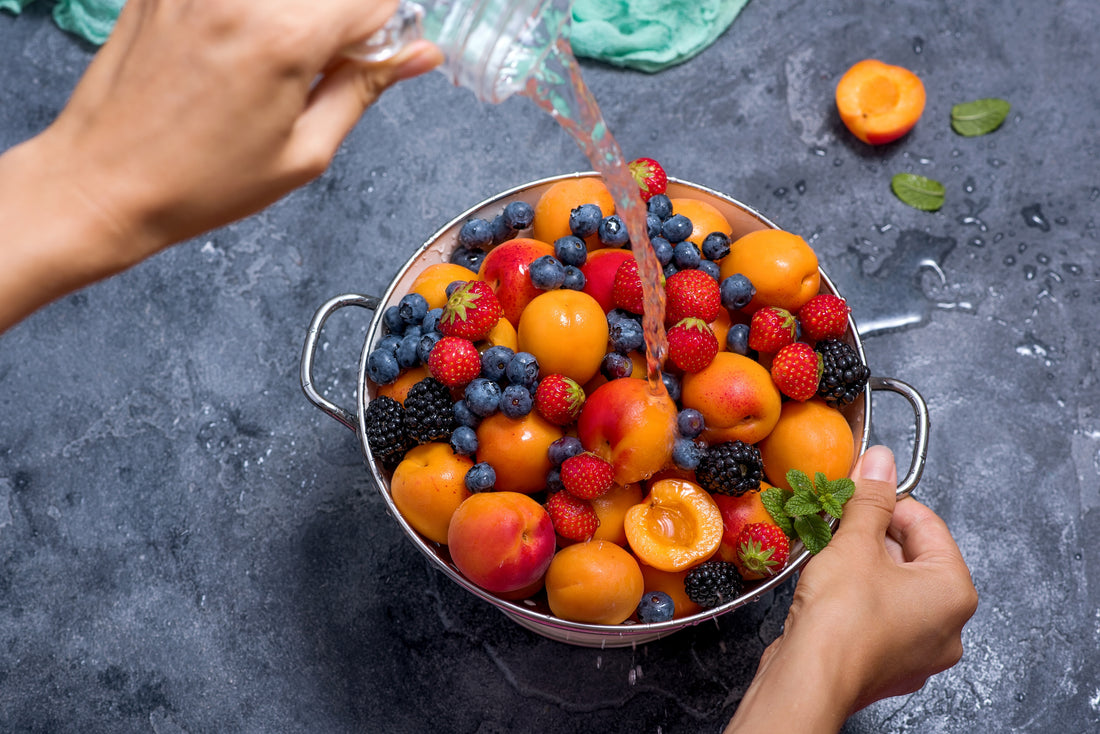It is easy to forget about the journey our food takes before it reaches our plates. However, being mindful of where our fruits and vegetables come from and how they are grown is crucial for our health and well-being.
One thing that is also overlooked is proper vegetable and fruit washing. Ensuring that your produce is squeaky clean not only enhances its taste but also protects you from potential food safety hazards.
Washing fruits and vegetables is a non-negotiable step in meal preparation. It eliminates dirt, pathogens, and pesticides. This is especially pertinent for raw vegetables and fruit, as they won't undergo the sterilizing effects of cooking.
How to Wash Our Fruits & Veggies:
When washing your produce opt for using filtered water. An easy way to do this is getting a filter under your sink. I use the one by Hydroviv, it's pretty inexpensive and easy to install. For an added layer of cleanliness, you can incorporate natural cleaning agents into your washing routine:
- Vinegar: Mixing one part vinegar with three parts water creates an effective produce wash. Soak your vegetables for a few minutes before rinsing thoroughly under cool water.
- Baking Soda: Make a paste using baking soda and water, then gently scrub your vegetables with this mixture. Rinse well afterward.
- Salt: A saltwater solution can help remove stubborn dirt and pesticide residues. Dissolve a tablespoon of salt in a bowl of water and soak your vegetables before rinsing.
- Store-Bought Cleaners: Some specialty produce washes, like those found at Trader Joe's, offer convenient options for those who prefer ready-made solutions. Follow the instructions on the label for best results.
Even if you are buying the “pre-washed” bags, it's advisable to wash them again, as they may still contain bugs and dirt. Because of this, I usually never buy anything pre-cut or washed, as it goes bad quicker and tends to be more expensive than washing and cutting it yourself.
Pesticides and Herbicides
Washing vegetables isn't just about removing visible dirt and bugs. It's also a crucial step in reducing pesticide and herbicide residues that may linger on the surface. By washing your produce thoroughly, you can minimize your exposure to these potentially harmful chemicals and protect your health in the long run. Additionally, proper washing can help reduce the risk of parasitic contamination, further enhancing the safety of your meals.
The Dirty Dozen:
These fruits and vegetables are best bought organic if possible and require thorough cleaning due to their higher pesticide contamination:
- Strawberries
- Spinach
- Kale
- Nectarines
- Apples
- Grapes
- Peaches
- Cherries
- Pears
- Blueberries
- Green Beans
- Bell & Hot Peppers
The Clean Fifteen:
If organic produce is not feasible, consider purchasing these 15 fruits and vegetables that typically have lower pesticide levels and are commonly available in non-organic options:
- Carrots
- Watermelon
- Sweet Potatoes
- Mango
- Mushrooms
- Cabbage
- Kiwi
- Honeydew Melon
- Papayas
- Asparagus
- Sweet Peas (Frozen)
- Avocados
- Sweet Corn
- Pineapples
- Onions
Understanding Food Labeling Numbers:
-
If the Sticker starts with 9: Indicates the product is certified organic, meaning it's grown and processed without synthetic pesticides, GMOs, or other harmful chemicals.
-
If the Sticker starts with 4: Denotes conventionally grown produce, meaning it may have been treated with synthetic pesticides and fertilizers.
-
If the Sticker starts with 8: Suggests the product contains genetically modified organisms (GMOs), indicating that it has been genetically altered in a laboratory to enhance certain traits or characteristics.

